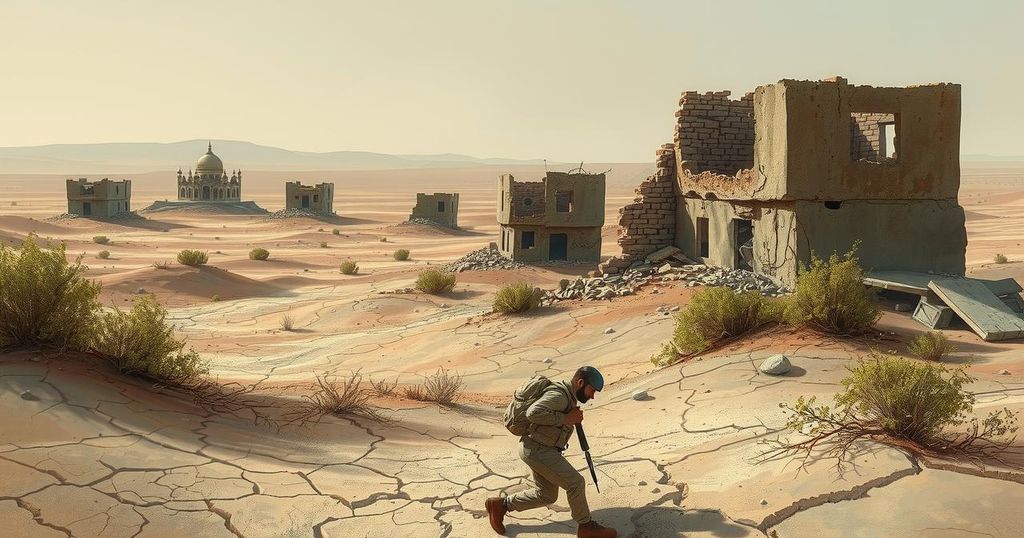Bashar Al Assad and his wife’s victory tour of Jobar highlights extensive damage from Syria’s civil war. The area faces reconstruction challenges, including financial, legal, and resource shortages. New leadership under Ahmad Al Shara promises a new direction, but international aid is contingent on stability and governance improvements. The situation remains critical, with many residents displaced and properties in disrepair.
Prior to the downfall of his regime last December, Syrian dictator Bashar Al Assad and his wife Asma conducted a series of victory tours in formerly rebel-held territories reclaimed by his forces. One of the most conspicuous was their 2018 visit to Jobar, a town adjacent to Damascus, which bore witness to catastrophic destruction during the civil war. The Assad regime bombarded Jobar for four years, leaving nearly every structure in ruins due to artillery fire, aerial bombings, and attacks from Russian forces.
Weeks after Jobar fell, regime-associated art students were brought in to embellish the walls of a rebel-dug tunnel, crafting sculptures to honor the very troops responsible for the town’s destruction. The artwork was purportedly intended to symbolize “martyrdom and peace,” but survivors like Haitham Al Bakhit, a former construction worker, contend that the regime not only obliterated Jobar but celebrated its annihilation, proclaiming, “Assad not only erased Jobar, he celebrated it.”
The dire state of Jobar serves as a stark representation of the extensive reconstruction challenges faced throughout Syria. The restoration process is impeded by the absence of international financial support, as well as regional instability and resource shortages. There is a precarious volatility in the Syrian pound’s exchange rate, further complicating commercial endeavors and a significant departure of skilled laborers has left a gaping void in the workforce necessary for rebuilding.
According to a United Nations report, one-third of all housing in Syria suffered damage or destruction during the war. Historical issues regarding property rights add to this complexity as the Assad regime’s five-decade-long arbitrary rule created a convoluted real estate landscape. The ownership of land and property remains ambiguous, particularly in locales where previous structures have been razed or repurposed by elite interests loyal to the former government.
Recently, Al Bakhit, who endured Jobar’s siege and eventual fall, returned to live with relatives near Damascus. He frequently revisits the ruins, noting that some former residents now shepherd their flocks in the area. Jobar, though administratively distinct from Damascus, functions as a neighborhood of the capital and remains rich with memories for those displaced.
The town’s Jewish synagogue, operational before the 1990s, similarly succumbed to the war. During the siege, deceased victims were washed in this historic building until it became too damaged for use. The eerie sculptures within the Jobar tunnels illustrate the contrasting realities of security and oppression experienced under the Assad regime, depicting soldiers engaged in seemingly benign actions, a stark divergence from the regime’s repressive legacy.
Ahmad Al Shara, the new leader following HTS’s takeover, has asserted a commitment to establishing a new government and guiding Syria towards recovery. Al Shara, formerly linked to Al Qaeda, faces significant challenges, including reconstruction financing amid persistent sanctions and a lack of institutional credibility, yet some Western aid restrictions have been relaxed under his leadership.
Western diplomats indicate that there might be a renewed willingness to invest in post-Assad Syria, but support hinges on Al Shara’s ability to navigate regional tensions and demonstrate a unified leadership away from extremist factions.
The road to recovery for Syria, exemplified by the destruction of Jobar, faces immense challenges. Rebuilding will require not only substantial funding and international consensus but also improved governance free from past repressive regimes. The effective reintegration of displaced persons and skilled labor will be critical to revitalizing the economy and restoring public services in the wake of decades of war and corruption.
Original Source: www.thenationalnews.com




